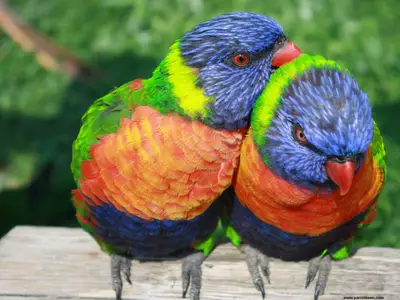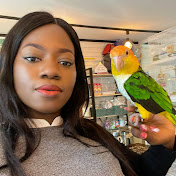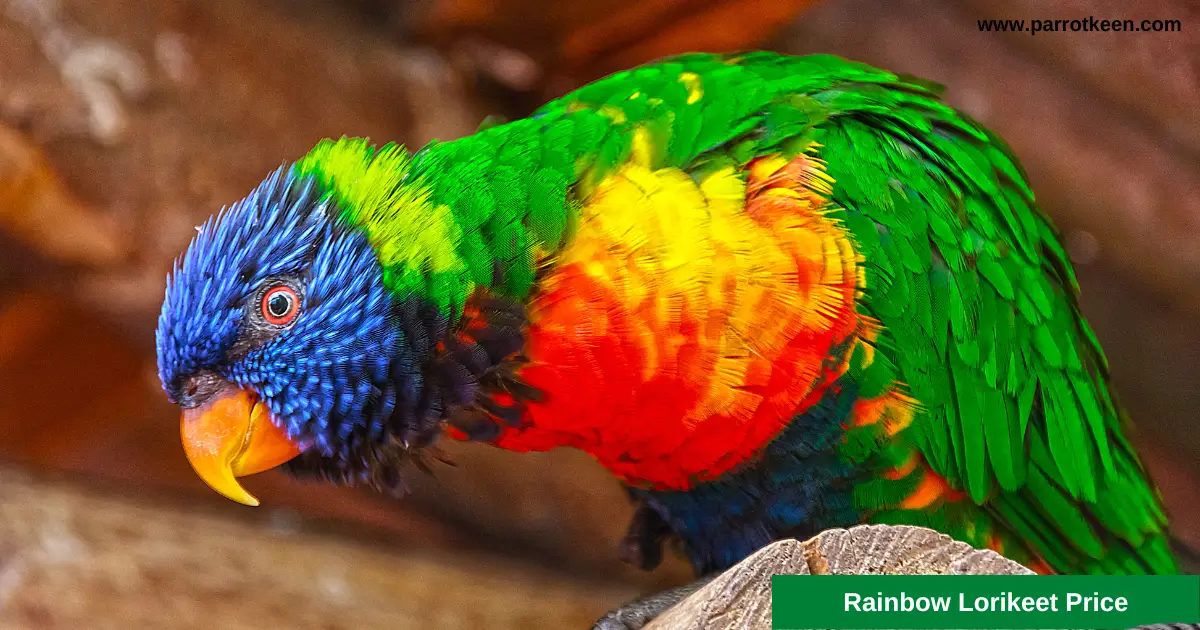
How Much Does Rainbow Lorikeet Cost?
You may be wondering about the exact rainbow lorikeet price especially If you are a lover of rainbow lorikeets then you will be very interested in getting yourself one. To do that you need to know the price of rainbow lorikeets.
Because of their exuberant personalities, rainbow lorikeets make very excellent pets and companions.
When purchasing one, you must take into account the cost of the lorikeet, cages, and the special nectar food that they eat.
They can be filthy birds because this meal is primarily liquid, so you might need to purchase additional cleaning supplies.
There are more than 50 different lorikeet species, but the most popular among them is the rainbow lorikeet. Being popular means that the price range for rainbow lorikeets will be a bit steep.
In this blog post, we will share with you every information you will need to know about rainbow lorikeet price.
Rainbow Lorikeet Price
Rainbow lorikeet is the first choice among the different breeds of Lorikeets, so if you are considering getting yourself one, it is important to know that Rainbow Lorikeet, typically costs between $400 and $700.
However, If you’re considering purchasing another variety of Swainson’s Lories, the price of these birds from top-notch breeders could exceed $1,000.
What Factors Will Effect The Cost While Purchasing A Rainbow Lorikeet?
If your lorikeet has unusually colorful and healthy-looking feathers, they will be valued higher since appearances matter when it comes to rainbow lorikeet pricing.
The price will probably decrease if the bird has any wounds, flaws, or damage to itself. On the other hand, the price may increase if the bird has an uncommon or distinctive appearance that is attractive to the eye.
One would need to purchase a pair of these birds if one were interested in breeding them. When doing so, you may frequently purchase two birds for a somewhat reduced cost compared to if you were to purchase them separately.
The genealogy of the lorikeet can be determined through DNA testing, which is available for a small cost.
This can help determine whether the bird has any hereditary problems and will tell you whether it is a purebred or hybrid.
How Does The Cost Of A Lorikeet Change With Age?
A rainbow lorikeet’s lifespan is approximately 20 years, so keep that in mind since you might not immediately think about a bird’s age.
A baby lorikeet will be extremely delicate, lack feathers, and require hand upbringing, which takes a lot of time and care.
It is not advised to purchase a hand-reared lorikeet even though it will be less expensive.
A lorikeet’s price will increase once it has finished weaning and can now eat adult foods. The cost rises as the bird matures and gets stronger as it enters its young life.
However, when a rainbow lorikeet gets older, the cost of the bird will start to drop after a while. If you don’t mind getting an older pet bird, you might be able to get a lorikeet for nothing at one of your neighborhood shelters.
If it is not clear to you, DNA testing can be done to identify gender.
Male and female lorikeets are priced differently, although not significantly. Watch the video below to see a pet rainbow lorikeet in action:
What is the Best Time to Buy Rainbow Lorikeets and Where to Buy them?
Breeders always want to raise rainbow lorikeet prices just before Christmas, but when they have finished weaning a lot of baby lorikeets that are now ready to be sold, the price may go down.
How much lorikeet costs will vary depending on where you reside in the world. Because lorikeets originate in Australia and Indonesia, these nations will charge less for them, especially Indonesia, which has lower exchange rates.
However, even within Australia or Indonesia, the cost will differ because the natural habitat of these birds does not extend across the entire nation. In areas of the country where these birds are not naturally found, higher costs will be sought.
Other rarer subspecies might not be possible to acquire, however, common species like Rainbow Lorikeets are so abundant in Australia that they are not protected by any laws and regulations. It will be necessary to conduct more research on these birds.
You’ll need a travel cage or carrier when you get your lorikeet so that you can get the bird from the breeder to your house.
Some breeders might sell you this cage for an additional cost. Alternatively, if you have a car and a travel cage, you should be able to drive to the breeder to make arrangements for the pick-up.
If the trip is lengthy, take into account the potential increase in fuel costs.
Is It Permitted To Keep Lorikeets?
Due to its widespread distribution, rainbow lorikeet ownership is permitted in Australia. The rules that apply to your state or country should still be confirmed with a local bird owners association or a national pet bird-owning organization.
It is strongly advised that you conduct online research on the breeder’s name before purchasing to read customer testimonials. No matter how appealing the offer may seem, stay away from breeders with a terrible reputation.
Signs To Not Purchase A Lorikeet
If the lorikeet is priced significantly higher or cheaper than it should be (between $400 and $700), this may be a sign of fraud or another problem. Remember that some subspecies may have greater prices.
For a claim of the bird’s genetic purity or lineage to be supported by DNA evidence, it must be made. Lower prices outside of the regular range could be a sign that the bird is sick, misbehaving, being sold illegally, or being bred in a mill.
How Much Will the Lorikeet Cages, Tools, and Supplies Set Me Back?
There are other costs associated with caring for the lorikeet throughout its existence, in addition to the cost of the bird itself.
First, there is the lorikeet cage, which will probably cost you at least $100 and up to $300 for higher-end cages.
To transport the bird to and from the veterinarian, you will need a bird carrier or travel cage. This will cost you at least $50, but better versions of these cages can run you anywhere from $100 to $200.
Perches are required for any cage inside, and you should be able to get them for $20 to $30.
Because they consume nectar, lorikeets have distinct dietary needs and need specialized food. The price of this meal in packages ranges from $25 to $50.
Because they consume a liquid-based diet, lorikeets produce a lot of waste that needs to be cleaned up. Liners for bird cages and cleaning supplies might be a recurring expense, costing you $10 to $20 each time you restock.
Insurance is worthwhile to purchase on a monthly or yearly basis because it will help you save money in the event of a medical emergency.
To keep your lorikeets entertained, you should also buy a couple of toys, which will run you between $10 and $20.
Annual visits to the vet can be expensive but are advised to monitor the bird’s health and to get advice from a professional.
If purchasing from a breeder, be sure to check out everything they have to offer because occasionally they may be able to throw in some supplies to get you started with your bird.
Additionally, be aware that all of this equipment will require space in your home or apartment, so plan and measure the space.
The Time And Energy Costs
Every day, you should spend at least an hour with your rainbow lorikeet, while many hours are very advised.
Additionally, these birds don’t like to be left alone, so it’s preferable if you have another bird to keep them company.
The rainbow lorikeet needs to spend a lot of time outside of its cage so that it can use up all of its energy.
Each day, you’ll need to spend time filling off the water and food, as well as cleaning the cage quickly and thoroughly once a week.
Additionally, you might want to spend some time training your rainbow lorikeet so that it is more obedient, able to wear a harness, and easier to move around.
By giving your bird opportunities to interact with different family members and other birds, you can keep it from becoming overly attached to you.
Additionally, you’ll need to have some patience to put up with the noises that lorikeets make.
Signs That A Lorikeet Is In Good Health
- Active, very lively, and attentive
- Continuously consumes food and liquids throughout the day.
- When examined closely, the eyes appear dry and lively.
- The body will appear normal, with legs, a beak, and feet.
- Plumes will appear well-kept and in good shape.
Warning Signs To Keep In Mind
- A beak that is not in good health, usually swollen or accumulating
- Does not appear to be very active, usually appearing melancholy or sitting somberly on the cage floor. Plumes, when closely examined, are plucked, fluffed, and/or discolored in appearance.
- The stool is runny and discolored rather than sturdy.
- A limp that can be felt when moving around
- Discharge coming from the eyes
- Irritated eyes
- It’s not eating or drinking like it usually does.
The Most Common Health Issues
Fluffed plumes, a nasal discharge, and/or a loss of appetite are some classic signs of chlamydiosis. If any of these symptoms appear, you should seek medical help right once.
Psittacine beak and plume sickness symptoms include an odd beak and/or uneven plume color. If any of these symptoms appear, get emergency assistance.
Conclusion: Rainbow Lorikeet Price
The liveliness and clown-like behavior of rainbow lorikeets are contagious. This may make them amusing at first, but over time, it also means they’ll require a lot of effort and care. Some folks might not be able to give this to their birds.
They might become your pals if you have the necessary spare time, money, and resources.
However, it’s a good idea to be sure you can meet all of the requirements outlined in this article before getting one of these birds.

Hi, I am Thersa and Welcome to ParrotKeen, your number one place to get all the information you need about your cute parrot. I hope You Find it useful.

